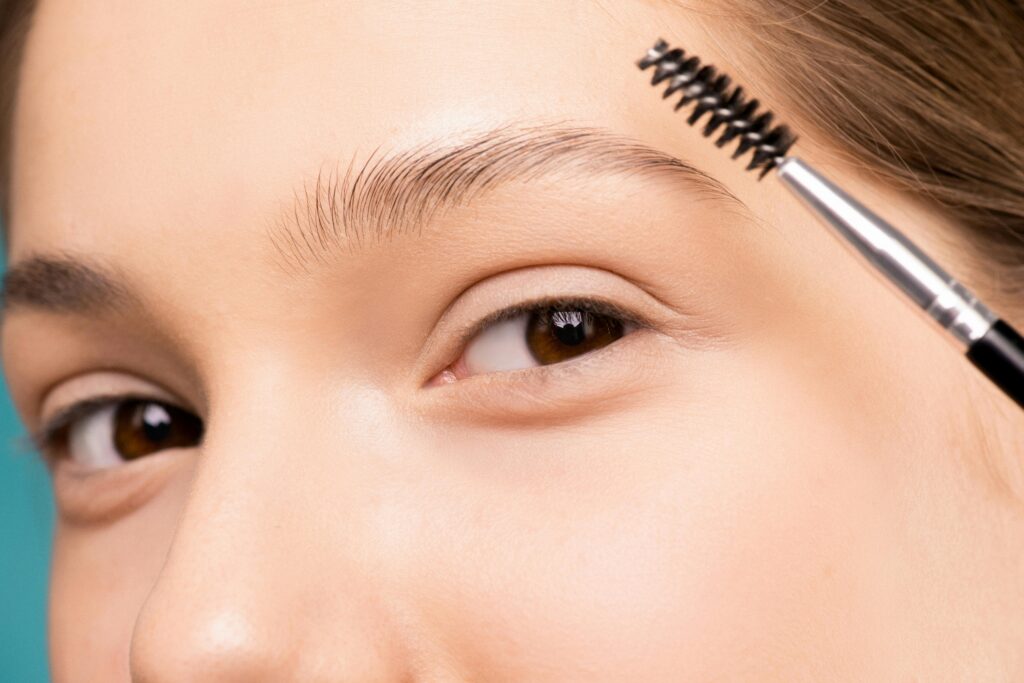Skin tone plays a crucial role in selecting the appropriate brow color. There are three main categories of skin tones: cool, warm, and neutral. Cool skin tones have pink, red, or blue undertones, while warm skin tones have yellow, peach, or golden undertones.
Neutral skin tones combine both cool and warm undertones. To determine skin tone, one can examine the veins on the wrist. Blue or purple veins indicate a cool undertone, green veins suggest a warm undertone, and difficulty distinguishing between blue and green may indicate a neutral undertone.
Sun reaction can also help identify skin tone. Cool undertones tend to burn easily and tan with difficulty, while warm undertones tan easily and rarely burn. Choosing a complementary brow color involves matching it to the skin tone.
Cool undertones generally suit ashier shades of brown or taupe, warm undertones work well with warmer browns or auburn, and neutral undertones can accommodate various brow colors from soft brown to medium taupe. Identifying Natural Brow Color
Determining one’s natural brow color is essential when selecting a brow product. Natural brow color may differ from hair color and can vary in shade and undertone.
For example, blonde hair may correspond to light taupe or ash blonde brows, light brown hair to medium brown or soft taupe brows, and dark brown or black hair to deep brown or black brows. It is important to consider any variations within the brows, as some individuals may have lighter or darker patches. Closely examining the natural brow color helps in choosing a product that blends seamlessly and appears natural.
Understanding the undertones of natural brow color can further guide product selection. Cool undertones in natural brows may be complemented by ashy or taupe shades, while warm undertones may be enhanced by warmer brown or auburn shades.
Choosing the Right Brow Product
Choosing the Right Brow Product for Your Skin Tone and Brow Type
When it comes to choosing a brow product, it’s essential to consider your skin tone and natural brow color. With so many options available, including pencils, pomaves, powders, gels, and markers, it can be overwhelming. However, by understanding the benefits and finishes of each type of product, you can make an informed decision that suits your personal preferences and skill level.
Choosing the Right Product for Your Brow Needs
Pencils are ideal for creating precise lines and filling in sparse areas with short, hair-like strokes. Pomades are perfect for those who want to sculpt and define their brows with a bolder, more dramatic look. Powders are great for a soft, natural finish and are easy to blend for a seamless result. Gels are excellent for taming unruly brows and adding volume and hold. Markers are a newer addition to the brow product lineup and are fantastic for creating a microblanding effect with ultra-fine strokes.
Considering Longevity and Wear Time
When choosing a brow product, it’s also important to consider the longevity and wear time. Some products are waterproof and long-lasting, making them ideal for all-day wear or special occasions. Others may offer a more natural or soft hold for everyday use. It’s also important to consider the level of pigmentation in the product and how it will interact with your natural brow color.
Tips for Achieving a Natural Look
Opting for a product that is one shade lighter than your natural brow color can help prevent an overly harsh or unnatural look. By choosing the right product and considering your skin tone, brow type, and personal preferences, you can achieve a natural-looking brow that enhances your natural beauty.
Matching Your Brow Color to Your Hair Color
Matching your brow color to your hair color is essential for achieving a cohesive and balanced appearance. While your brows don’t need to be an exact match to your hair color, they should complement and harmonize with it. For those with lighter hair colors such as blonde or light brown, choosing a brow color that is one to two shades darker can help define the brows without overpowering the face.
This subtle contrast adds depth and dimension to the brows while maintaining a natural look. On the other hand, individuals with darker hair colors such as dark brown or black may opt for a brow color that closely matches their hair color or is one shade lighter. This can help create a polished and put-together look without appearing too harsh or severe.
It’s important to consider the undertones of both your hair color and natural brow color when selecting a matching brow product. Cool-toned hair colors pair well with cool-toned brow products, while warm-toned hair colors complement warm-toned brow products.
Considering Your Personal Style
When choosing a brow color, it’s important to consider your personal style and the overall look you want to achieve. Your makeup preferences, fashion choices, and lifestyle can all influence the type of brow product and color that will best suit you. For those who prefer a more natural and minimalistic approach to makeup, opting for a soft brow powder or pencil in a shade that closely matches their natural brow color can help enhance their features without looking too done up.
On the other hand, individuals who enjoy experimenting with bold makeup looks may gravitate towards pomades or markers in darker or more intense shades to create statement brows. Considering your personal style also involves thinking about the occasions and settings in which you will be wearing your chosen brow product. For everyday wear, a subtle and understated brow color that complements your hair color and skin tone may be most suitable.
However, for special events or evening looks, you may want to play with bolder shades or more defined techniques to make a statement.
Testing Different Shades
Before committing to a specific brow product or color, it’s essential to test out different shades to find the most flattering option for you. Many beauty stores offer testers or samples of brow products that allow you to swatch and compare various shades on your skin before making a purchase. When testing different shades, it’s important to consider how they look against both your natural brow color and your skin tone.
Take note of how each shade blends in with your brows and whether it complements your overall look. It’s also helpful to assess how each shade wears throughout the day and how it interacts with other makeup products you typically use. Testing different shades can help you narrow down the options and make an informed decision based on what works best for you.
Seeking Professional Advice
If you’re still unsure about which brow color is right for you, seeking professional advice can provide valuable insight and guidance. Beauty experts at makeup counters or beauty salons can offer personalized recommendations based on your unique features and preferences. They can assess your skin tone, natural brow color, and overall style to recommend the most suitable brow products and shades for you.
Additionally, professional makeup artists can provide demonstrations and tutorials on how to use different brow products effectively to achieve your desired look. They can also offer tips on shaping and grooming your brows to complement the chosen color. Seeking professional advice can be especially beneficial for those who are new to using brow products or want to elevate their makeup game with expert guidance.
In conclusion, choosing the right brow color involves understanding your skin tone, identifying your natural brow color, considering your personal style, testing different shades, and seeking professional advice when needed. By taking these factors into account, you can select a brow product that enhances your features and complements your overall look seamlessly. Whether you prefer a soft and natural finish or a bold and defined statement, there is a perfect brow color out there for everyone.
FAQs
What factors should I consider when choosing my brow color?
When choosing your brow color, consider your natural hair color, skin tone, and personal preference. It’s important to choose a shade that complements your natural features and looks natural on your face.
How do I match my brow color to my natural hair color?
To match your brow color to your natural hair color, choose a shade that is one to two shades lighter if you have dark hair and one to two shades darker if you have light hair. This will help create a natural and balanced look.
What should I consider when choosing a brow color based on my skin tone?
When choosing a brow color based on your skin tone, consider whether you have warm or cool undertones. If you have warm undertones, opt for a brow color with warm tones such as golden or reddish-brown. If you have cool undertones, choose a brow color with cool tones such as ash or taupe.
Should I consider my eye color when choosing a brow color?
While it’s not necessary to consider your eye color when choosing a brow color, some people prefer to match their brow color to their eye color for a harmonious look. However, it’s more important to focus on your natural hair color and skin tone when choosing a brow color.
What are some tips for choosing the right brow color?
Some tips for choosing the right brow color include testing the shade on your skin before purchasing, considering your natural hair color and skin tone, and seeking advice from a professional if you’re unsure. It’s also helpful to choose a brow color that is one to two shades lighter than your natural hair color for a more natural look.



